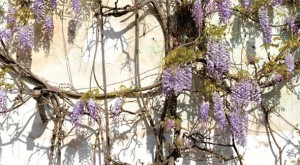 Q. I have a well established, twenty-year old Wisteria climbing up the front of my porch. By now, the growth is out of control. Can I trim it back during the year without jeopardizing next spring’s blooms? Also, how might I help increase the flowering, as there isn’t an abundance of blossoms?
Q. I have a well established, twenty-year old Wisteria climbing up the front of my porch. By now, the growth is out of control. Can I trim it back during the year without jeopardizing next spring’s blooms? Also, how might I help increase the flowering, as there isn’t an abundance of blossoms?
A. There is a reluctance of gardeners to prune deciduous vines, fruit trees and roses once the primary winter pruning season is completed. When quizzed why not the most common answers are, “it may die,” or, “it will stop blooming.” The reality is, plants never die from such pruning practices; however, flowering issues may develop related to off-season pruning depending on the species. Spring flowering plants and trees such as plums, pears, cherries redbuds, lilacs and wisterias are best pruned after flowering. The only harm in pruning earlier during the winter months is the removal of the spring flowering wood that reduces the show of color. Wisteria as you have mentioned is an aggressive grower, so an annual pruning is required to keep them contained. It is okay to continually shape the plant during the growing season by pruning off or back any of the growth that is growing in the wrong direction. Wisteria blooms on the second year and older wood or shoots. With my Wisteria, I’m forever cutting the new growth out of the eves of the house, floodlights and a nearby orange tree. I’m not worried about the flowers as there will be plenty of growth for the Wisteria to bloom on next spring. You can improve the flowering by lowering the soil pH. The pH scale is from one to fourteen with seven being neutral. Any reading above eight is said to be alkaline while soils below seven are said to be acidic. Wisteria likes a soil pH around six to six point five. You can purchase a simple pH kit at your favorite garden center. Since our soils are somewhat alkaline, I’d apply Soil Sulphur or GreenAll pH Adjuster to lower the soil pH. With the beginning of the rainy season, it’s an excellent time to apply these products. Soil Sulphur or GreenAll pH Adjuster is also beneficial to Blueberries, Azaleas, Camellias, Rhododendrons, Gardenias, and other shade loving plants.
Q, I recently sowed Dichondra seed between the stepping-stones in my backyard. I’m now noticing some thin grass starting to pop up. Is there a weed killer that you can use on dichondra to control weeds. I’ve heard that some weed killers won’t work because Dichondra is actually considered a broadleaf plant and the weed killer would kill the dichondra as well. Is this correct?
A. Yes, Dichondra is a broadleaf plant and not a grass. Thus any of the broadleaf-weed killers or herbicides would wipe out the Dichondra. But all is not lost. Ortho Grass-B-Gon is a selective herbicide for grassy weeds in broadleaf plants. It can be used on Dichondra for the unwanted grass. You’ll then have to manually remove any of the broadleaf weeds that sprout.
Buzz Bertolero is Executive Vice President of Navlet’s Garden Centers and a California Certified Nursery Professional. His web address is www.dirtgardener.com and you can send questions by email at dirtgarden@aol.com or to 360 Civic Drive Ste. ‘D’, Pleasant Hill, Calif. 94523 and on Facebook at Facebook/.com/Buzz-Bertolero







